10 Best AI Data Analytics Tools

As marketing issues become more complex by the day, advanced methods are needed to understand them.
Traditional methods of data analysis were heavily dependent on manual processes and limited computer capabilities. But with the advent of AI tools, a new era has begun.
These advanced tools harness the power of machine learning and deep learning algorithms to extract valuable insights, automate repetitive tasks, and uncover hidden patterns in large data sets.
With the use of AI, data analysts can now solve complex problems more efficiently and accurately, transforming the resources of data analytics. We’ll explore the best AI data analytics tools that are changing the way businesses make data-driven decisions.
Why to use AI for Data Collection?
There are a number of steps in using AI to perform data analytics that can dramatically increase the depth and efficiency of insights from data. Here is a detailed guide on how to use AI for data analytics.
1. Data Collection
Start by collecting data from various sources. This could be databases, spreadsheets, social media, sensors, or web scraping. AI tools can automate data collection, ensuring detailed and timely data.
2. Data Preparation
Clean and preprocess data to ensure it is accurate and ready for analysis. This phase involves handling missing values, removing duplicates, normalizing data, and transforming data sets. AI-powered tools can clean data, reduce manual effort, and improve data quality.
3. Exploratory Data Analysis (EDA)
Use AI to perform EDA, which involves summarizing key characteristics of data, often using visual techniques. AI can identify patterns, correlations, and outliers that aren’t immediately obvious.
4. Feature Engineering
Enhance the dataset by creating new features from existing data. AI can help by providing the right automation features that improve the performance of predictive models.
5. Model Selection
Select appropriate AI models for analysis, such as regression, classification, clustering, or neural networks. Many AI platforms offer automatic machine learning (AutoML) to help select and optimize models based on certain data sets.
6. Training and Evaluation
Train AI models using prepared data and evaluate their performance using metrics such as accuracy, precision, recall, and F1 scores. AI tools can automate the training process and provide insights into model performance, helping to optimize models.
Also Read: Best AI Presentation Makers
Top 10 AI Data Analytics Tools
1. Tableau
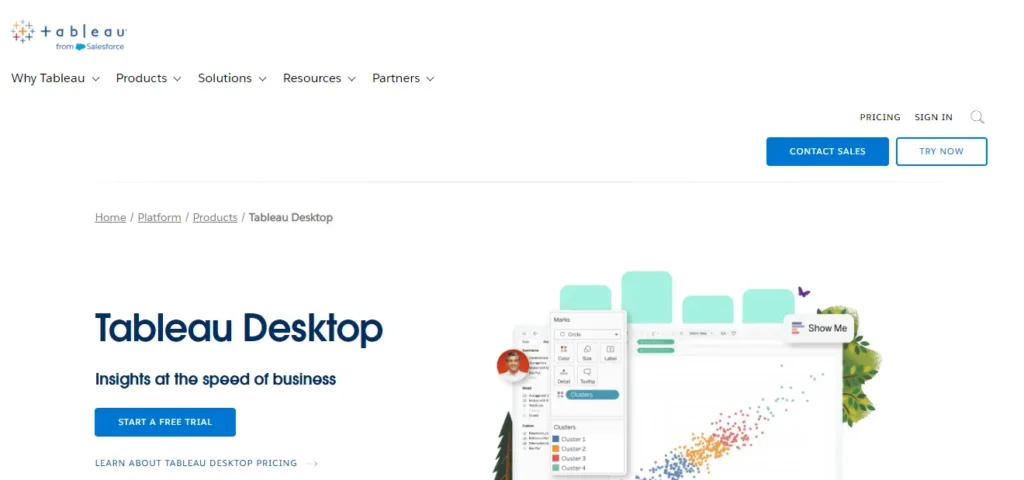
Tableau is a powerful data visualization tool that helps users visualize and understand their data. It provides easy drag-and-drop capabilities to create interactive charts, graphs, maps, and dashboards.
Tableau uses AI-powered analytics to integrate its data sources to deliver insights, identify trends, and optimize data visualizations Its advanced analytics features include predictive analytics, statistical processing, and natural language processing (NLP) capabilities that make data accessible to technical and non-technical users
Features –
– Drag-and-drop interface for convenient data visualization
– Interacting with multiple data sources
– AI-powered data insights and trend identification
– Interactive dashboards and reports
– Easy sharing and collaboration of design
– Advanced analysis such as predictive analysis
– Natural language processing for querying data
Survey:
– Develop interactive dashboards for business intelligence
– Analyzing complex data to uncover trends and insights
– Sharing images and reports with stakeholders
– Performing real-time data analysis
– Providing data-driven storytelling for improved content
– Monitor key performance indicators (KPIs).
– Supports data-driven decision-making across multiple sectors (marketing, finance, etc.).
2. Power BI
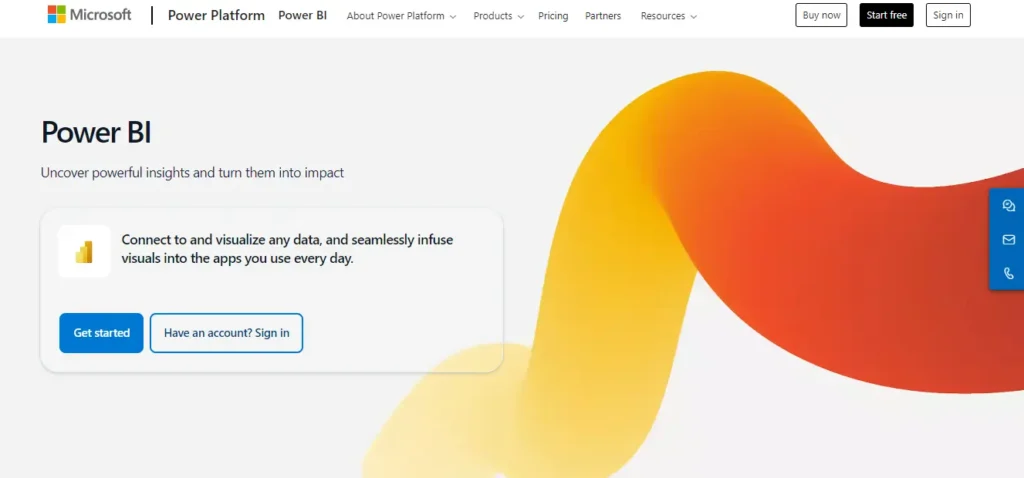
Power BI by Microsoft is a business analytics service that provides interactive visualization and business intelligence capabilities with an intuitive interface for end users to create their reports and dashboards.
It includes multiple data sources and uses AI use for data preparation, visual recognition, and data model development.
Its integration with Microsoft products and services enhances its value, making it the preferred tool for companies that rely on the Microsoft ecosystem.
Features –
– Simple interface for creating reports and dashboards
– Integration with Microsoft products (Excel, Azure, etc.).
– Interacting with data sources
– AI-powered data creation and analysis
– Real-time data management
– You can change your image
– Mobile access to reports and dashboards
Survey:
– Generation of custom reports and dashboards for business analysis
– Integration with Microsoft Office tools for easy collaboration
– Analysis of sales and marketing performance
– Monitor the efficiency of financial planning and operations
– Collaborate on data insights across teams
– Developing data analysis and prediction
– Provide real-time data monitoring and alerting
3. Google Analytics
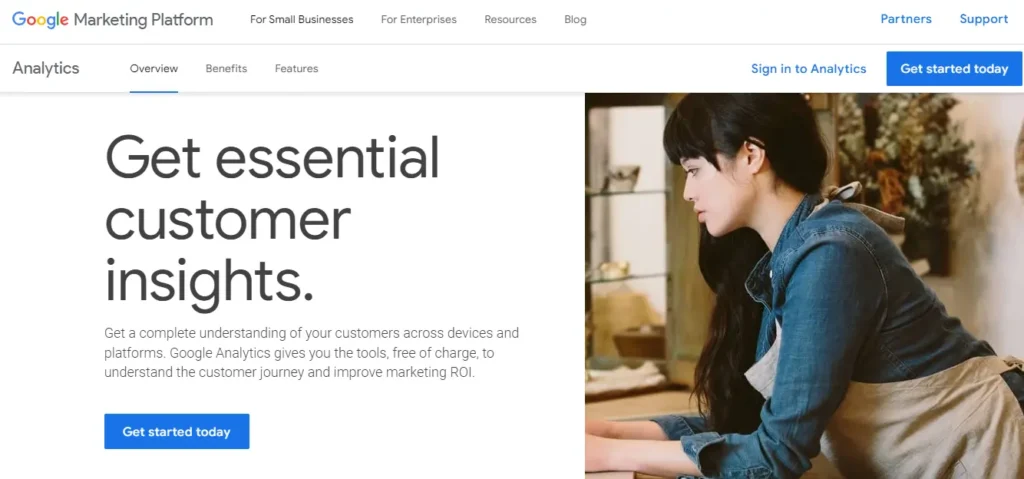
Google Analytics is a widely used web analytics service provided by Google that tracks and reports on website traffic.
It provides real-time data insights, helps users understand user behavior, measures marketing ROI, and improves website performance.
Enabled by AI, it includes machine learning models for predictive analytics, anomaly detection, and automated vision, making it easier to spot trends and take action based on data
Features –
– Monitors and reports on web traffic
– Real-time data insights
– User behavior analysis
– Marketing ROI measurement
– AI features such as predictive analytics and anomaly detection
– Customizable reports and dashboards
– Easy integration with other Google services (ads, search console) .
Survey:
– Monitor website traffic and user behavior
– Measuring the effectiveness of online marketing campaigns
– Analysis of e-commerce performance and user journeys
– Identify effective words and keywords
– Understand audience demographics and interests
– Establish and execute change objectives
– Conducting A/B testing to optimize web pages
4. IBM Watson Analytics
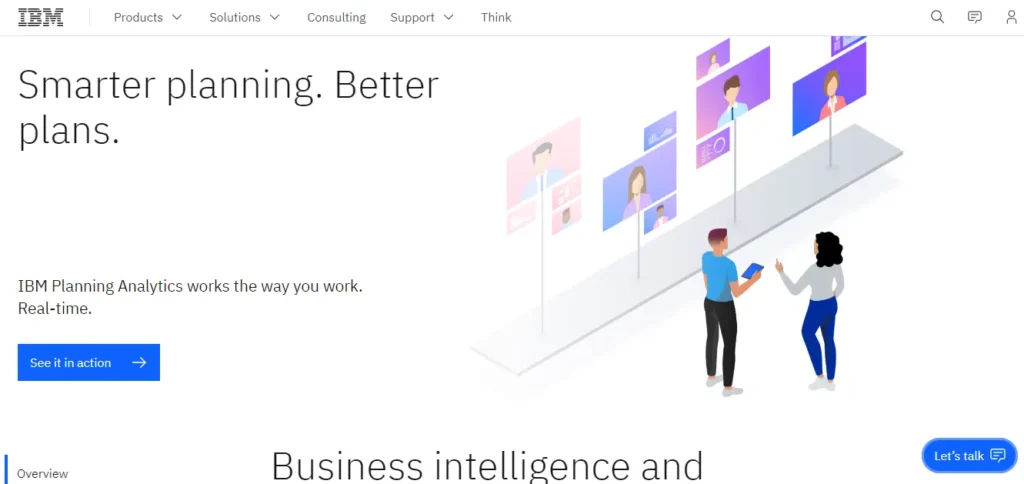
IBM Watson Analytics is an intelligent data analysis and visualization service powered by IBM’s AI. Enables data preparation, predictive analytics, and visual storytelling.
Watson’s natural language processing enables users to ask questions in plain language and gain actionable insights.
The tool’s advanced analytical capabilities are designed to help businesses make data-driven decisions by identifying patterns and hidden trends in their data
Features –
– The characteristics of the character
– Preliminary analysis and trend identification
– A visual storytelling tool
– Natural language processing for data queries
– Easy to understand
– Integration with data sources
– AI-driven data visualization
Survey:
– Automating data creation and analysis
– Performing predictive analytics to predict
– Provides graphics and reports for operational insights
– Using natural language queries to analyze data
-Evaluate customer sentiment and feedback
– Improve decision-making with insights from AI
– Integration with various data sources for comprehensive analysis
5. SAS Analytics
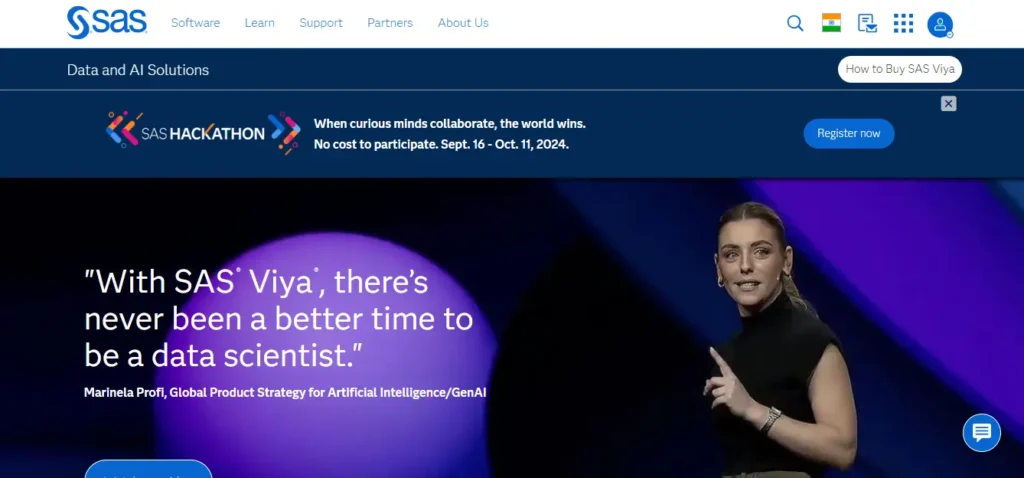
SAS Analytics is a comprehensive set of data analysis tools from SAS, known for its advanced statistical analysis capabilities.
It has features for data mining, predictive modeling, forecasting, and optimization. With the integration of AI and machine learning, SAS Analytics provides robust support for big data analytics, helping organizations unlock insights, improve decision-making, and improve business outcomes through sophisticated data analytics techniques
Features –
– Detailed statistical analysis
– Advanced modeling and forecasting
– Data analysis
– Machine learning integration
– Big data analytics support
– Adaptation and simulation capabilities
– Successful implementation
Survey:
– Advanced statistical and predictive analytics
– Performing data mining to identify patterns and relationships
– Building and implementing machine learning models
– Predict future growth and outcomes
-Effective coordination of work processes and resource allocation
– Analyze big data for strategic insights
– Supports research and development through robust data analysis
6. RapidMiner
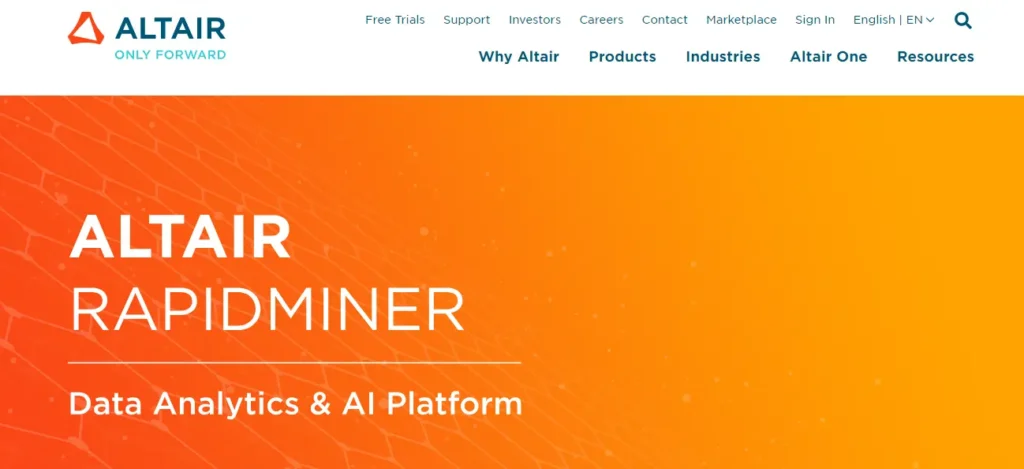
RapidMiner is an open-source data science platform that provides tools for data preparation, machine learning, deep learning, text mining, and predictive analytics.
Supports a wide range of data sources and algorithms, making it a capable tool for data scientists and researchers a lot of work RapidMiner’s easy-to-use, rule-free environment enables users to develop, train, and optimize machine learning models to accelerate the data analysis process
Features –
– Lack of rule-free environment for data science
– Preparation and blending of data
– Machine learning and deep learning
– text mining capabilities
– to indicate research
– Integration with multiple data sources
– Coordinated model creation and deployment
Survey:
– Generate and blend data from multiple sources
– Building machine learning and deep learning models
– Performing predictive analytics for performance forecasting
– Performing text mining to analyze unstructured data
– Automating data science workflows and model deployment
– Supporting academic research and teaching in Data Science
– Improve operational decisions through data insights
7. Qlik Sense
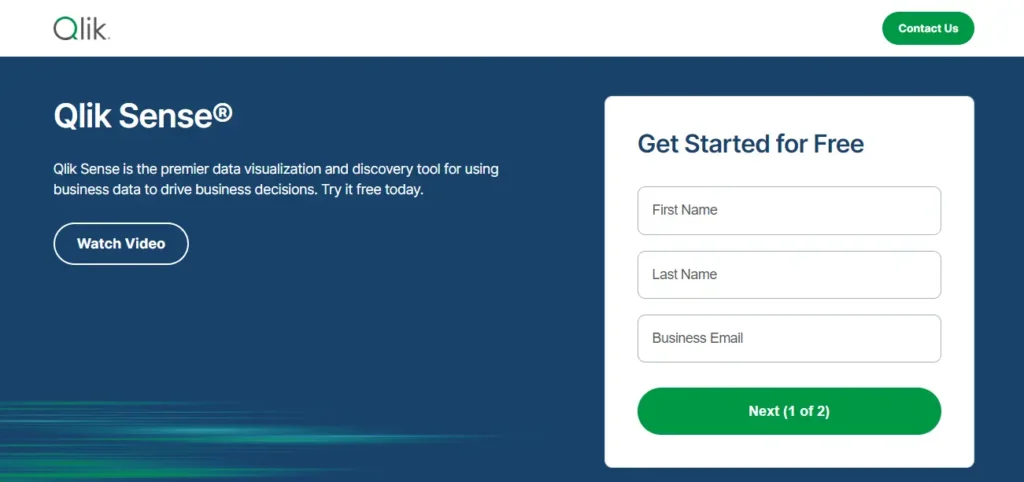
Qlik Sense is an automated data analytics tool that allows users to create personalized, interactive data visualizations.
It uses an interactive data cataloging engine that allows users to explore data independently and find hidden insights. AI-powered features like augmented analytics, data storytelling, and smart search can help users make sense of complex data.
Qlik Sense provides robust data integration and preparation features, ensuring data consistency and reliability.
Features –
– Self-service data visualization
– Indexing associative data for open search
– Advanced analytics and AI
– Data storytelling
– smart search for seamless data communication
– Robust data integration
– Creating reliable data
Survey:
– Create self-service data visualizations and dashboards
– Find data relationships with associative indexing
– Perform augmented analytics with the help of AI
– Create data stories to demonstrate insights
– Easy to navigate and search data through smart search
– Integrating and preparing data from multiple sources
– Real-time business performance monitoring
8. Looker
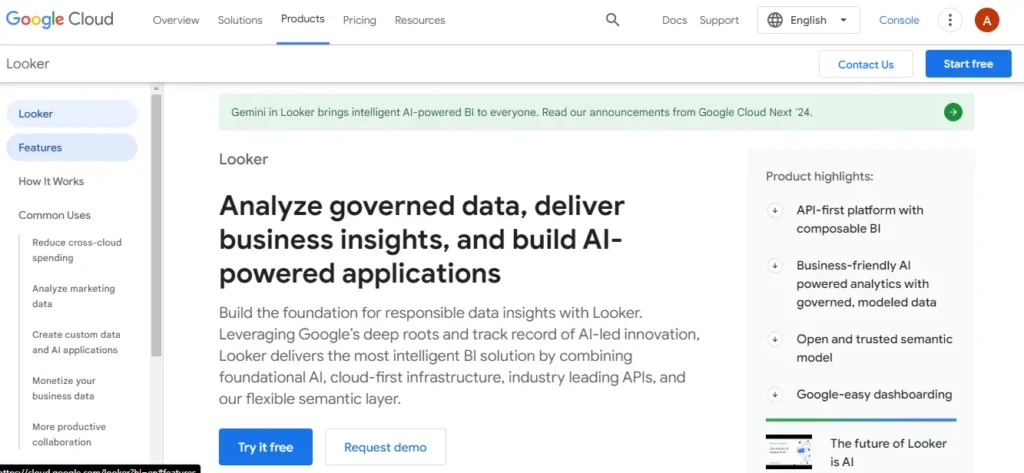
Looker is a modern data platform that allows companies to analyze and visualize their data. Hosted by Google Cloud, Looker provides powerful data modeling capabilities and seamlessly integrates with data sources.
Its built-in machine learning and AI functionality help users gain insights from their data. Looker’s unique approach to data analysis and its robust API capabilities make it a popular choice for businesses looking to integrate analytics into their operations
Features –
– Data modeling capabilities
– Seamless integration with data sources
– Machine learning and AI products
– Updatable data model
– Robust API for embedding analytics
– Real-time data acquisition and analysis
– Collaborative data analysis
Survey:
– Building data models for comprehensive analysis
– Create customizations and dashboards
– Embedding analytics in applications and operations
– Analysis of real-time data provides immediate insights
– Collaboration of data services between teams
– Benefits of AI for advanced data analysis
– Seamless integration with cloud services and databases
9. Alteryx
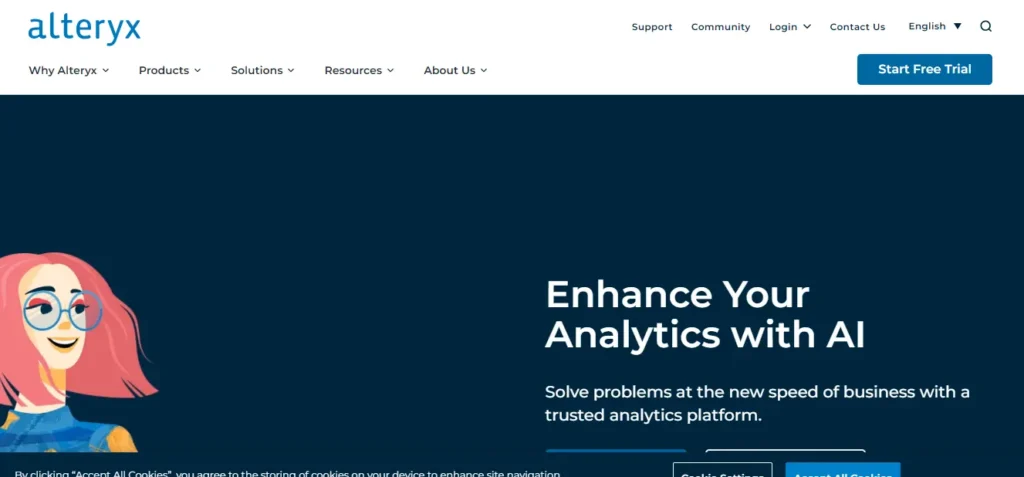
Alteryx is an end-to-end analytics platform that enables data blending, advanced analytics, and data science automation.
Providing an intuitive interface for data preparation, integration, and analysis, and making it accessible to users with varying technical backgrounds Alteryx’s AI and machine learning capabilities help users develop predictive model types, just perform routine tasks, and derive actionable insights from their data
Features –
– Intuitive interface for data preparation
– Data blending tool
– Advanced analytics and data science automation
– Advanced modeling and machine learning
– Repetitive use
– Applicable data insights
– Integration with multiple data sources
Survey:
– Preparation and blending of data for analysis
– Performing advanced analytics and data science automation
– Building and implementing predictive models
– Automating repetitive data tasks and workflows
– Provide actionable insights from data
– Supporting data-driven decision-making in various industries
-Integration with multiple data sources for comprehensive analysis
10. Domo
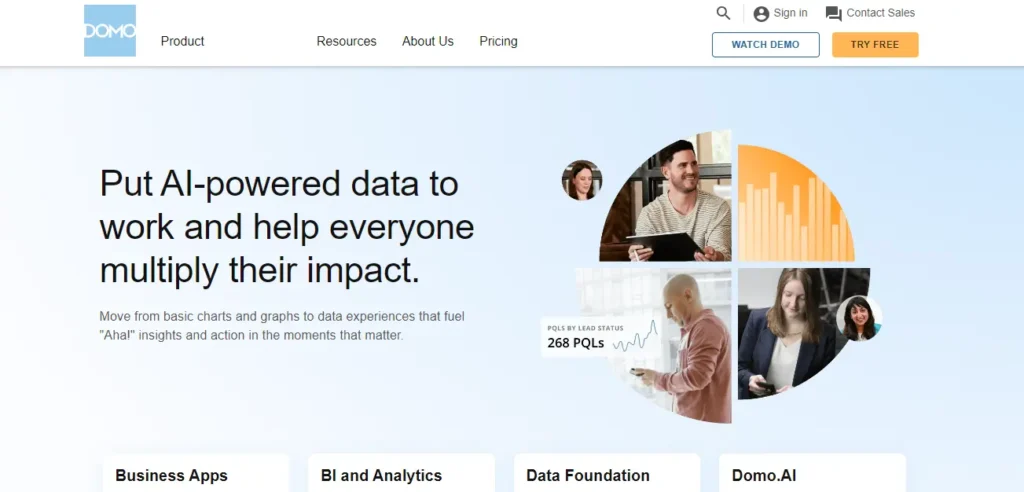
Domo is a cloud-based business intelligence platform that offers a wide range of data visualization and analysis tools. It includes multiple data sources and provides real-time data access and visualization.
Domo’s AI-driven analytics and predictive modeling capabilities help businesses spot trends and make data-driven decisions.
Its user-friendly interface and robust collaboration make it a valuable tool for organizations seeking to democratize data use and analysis.
Features –
– Cloud-based data access
– Real-time data visualization
– Interacting with multiple data sources
– AI-driven analysis and prediction
– User-friendly interface
– Working together to share insights
– Mobile access to analytics
Survey:
– Access and view data in the cloud
– Create dashboards and reports in real-time
– Interacting with multiple data sources for integrated analysis
– AI-driven analysis and prediction
– Enabling collaboration on data insights across the organization
– Monitor performance quality and KPIs
– Get analytics on mobile devices for on-the-go search
Suggested Read: Best AI Email Assistants
Final Thoughts
In conclusion, the advent of AI data analytics tools has dramatically changed how companies approach data analytics. Leveraging the power of machine learning and deep learning, these tools will provide unparalleled insights, simplify complex processes, and reveal patterns that were previously hard to find and when as the volume and complexity of data increases, the need for these AI-powered solutions only increases.
By adopting the best AI tools for data analytics, businesses can stay ahead of the curve, make more informed decisions, and ultimately win more As we move forward, there is no doubt that the integration of AI into data analytics will continue to revolutionize the industry, thereby understanding performance data And will pave the way for new and more efficient ways of using it.
FAQ’S
1. What is the best AI tool for Excel data analysis?
The best AI tools for Excel are Lumelixr AI, Zoho Sheets, Sheet AI and Numerous AI.
2. What do AI tools for data analytics do?
These tools help you look at a lot of data, find patterns, and get useful information. They do repetitive tasks automatically, making the analysis faster and more accurate, and helping businesses make better decisions based on data.
3. How do AI-based data analytics tools help businesses?
These tools help businesses by quickly analyzing large amounts of data, giving deeper insights, and finding trends that are hard to see with older methods. This helps businesses make smarter decisions, run more smoothly, and be more efficient.